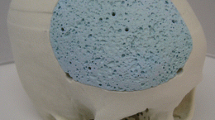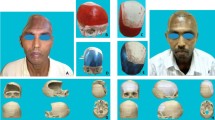Abstract
Objective The TICC (Tomography, Image processing, CAD, CAM) processing chain developed at the Ruhr-University Bochum in Germany has already been established since several years for the reconstruction of large pre-existing posttraumatic skull defects with individual prefabricated implants made of pure titanium. So far, more than 500 titanium implants have been inserted with great success at more than 60 clinical centres worldwide. The aim of our study was to evaluate all implants inserted between 1994 and 2000.
Materials and Methods The study describes the clinical experience with 166 patients receiving 169 skull implants between 1994 and 2000. All 169 implants were measured and categorized in the CAD system in terms of size and anatomical localization. The surgical and radiological reports of the patients were evaluated. Sixty patients operated at the university hospital in Bochum and nearby were clinically reviewed describing scars, position of the implants and cosmetic results. Questionnaires of 131 patients were analyzed regarding the postoperative quality of life distinctly.
Results The study shows constantly good to excellent results intraoperatively as well as postoperatively regarding complications, fit of the implants and the clinical follow-up. In particular the enquiry of the patients shows that titanium skull implants improve quality of life.
Conclusion High precision and easy handling as well as a low complication rate and the high contentedness of the patients make the individual titanium skull implants valuable for cranioplasty, especially in complicated applications with very large defects, multiple previous operations and additional irradiations. Even in these difficult cases predictable results are possible.
Similar content being viewed by others
References
Blake GB, MacFarlane MR, Hinton JW (1990) Titanium in reconstructive surgery of the skull and face. Br J Plast Surg 43:528–535
Bucheler M, Weihe S, Eufinger H, Wehmoller M, Bootz F (2002) Reconstruction of the frontal bone with individual titanium implants after surgical therapy of osteomyelitis of the frontal bone [German]. HNO 50:339–346
Costantino PD, Hiltzik D, Govindaraj S, Moche J (2002) Bone healing and bone substitutes. Facial Plast Surg 18:13–26
Costantino PD, Chaplin JM, Wolpoe ME, Catalano PJ, Sen C, Bederson JB, Govindaraj S (2000) Applications of fast-setting hydroxyapatite cement: cranioplasty. Otolaryngol Head Neck Surg 123:409–412
Dujovny M, Agner C, Aviles A (1999) Syndrome of the trephined: theory and facts. Critical Reviews in Neurosurgery 9:271–278
Dujovny M, Aviles A, Agner C, Fernandez P, Charbel FT (1997) Cranioplasty: cosmetic or therapeutic? Surg Neurol 47:238–241
Eufinger H, Wehmoller M (1998) Individual prefabricated titanium implants in reconstructive craniofacial surgery: clinical and technical aspects of the first 22 cases. Plast Reconstr Surg 102:300–308
Eufinger H, Wehmoller M (2002) Microsurgical tissue transfer and individual computer-aided designed and manufactured prefabricated titanium implants for complex craniofacial reconstruction. Scand J Plast Reconstr Surg Hand Surg 36:326–331
Eufinger H, Wehmoller M, Machtens E (1997) Individual prostheses and resection templates for mandibular resection and reconstruction. Br J Oral Maxillofac Surg 35:413–418
Eufinger H, Wittkampf AR, Wehmoller M, Zonneveld FW (1998) Single-step fronto-orbital resection and reconstruction with individual resection template and corresponding titanium implant: a new method of computer-aided surgery. J Craniomaxillofac Surg 26:373–378
Eufinger H, Wehmoller M, Scholz M, Harders A, Machtens E (1999) Reconstruction of an extreme frontal and frontobasal defect by microvascular tissue transfer and a prefabricated titanium implant. Plast Reconstr Surg 104:198–203
Eufinger H, Wehmoller M, Muller C, Falk A, Machtens E (2000) Pure titanium as bone substitute. Geometric and substance-specific aspects of computer-assisted fabrication and follow-up imaging [German]. Mund Kiefer Gesichtschir 4 (Suppl 2):504–508
Gladstone HB, McDermott MW, Cooke DD (1995) Implants for cranioplasty. Otolaryngol Clin North Am 28:381–400
Gliese M, Handel G, Brawanski A (2000) A simple and cosmetically ideal method large cranioplasty [German]. Zentralbl Neurochir 61:155–157
Govindaraj S, Costantino PD, Friedman CD (1999) Current use of bone substitutes in maxillofacial surgery. Facial Plast Surg 15:73–81
Kamyszek T, Eufinger H, Wehmoller M, Scholz M, Machtens E (2000) Reconstruction of cranial and craniofacial skull defects with individual CAD/CAM-prefabricated titanium implants—clinical and radiological experience with 76 patients treated at 19 centres from 1994 to 1998: In: Lemke HU, Vannier MW, Inamura K, Farman AG, Doi K (eds): CARS 2000—computer assisted radiology and surgery. Elsevier, Amsterdam, pp 875–880
Liao CC, Kao MC (2002) Cranioplasty for patients with severe depressed skull bone defect after cerebrospinal fluid shunting. J Clin Neurosci 9:553–555
Luparello D, Bruschi S, Verna G, Bogetti P, Datta G, Fraccalvieri M, Luparello V (1998) Cranioplasty with polymethylmethacrylate. The clinico-statistical considerations [Italian]. Minerva Chir 53:575–579
Pompili A, Caroli F, Carpanese L, Caterino M, Raus L, Sestili G, Occhipinti E (1998) Cranioplasty performed with a new osteoconductive osteoinducing hydroxyapatite-derived material. J Neurosurg 89:236–242
Schaller B, Graf R, Sanada Y, Rosner G, Wienhard K, Heiss WD (2003) Hemodynamic and metabolic effects of decompressive hemicraniectomy in normal brain. An experimental PET-study in cats. Brain Res 982:31–37
Schiller C, Rasche C, Wehmoller M, Beckmann F, Eufinger H, Epple M, Weihe S (2004) Geometrically structured implants for cranial reconstruction made of biodegradable polyesters and calcium phosphate/calcium carbonate. Biomaterials 25:1239–1247
Schwab S, Erbguth F, Aschoff A, Orberk E, Spranger M, Hacke W (1998) “Paradoxical” herniation after decompressive trephining [German]. Nervenarzt 69:896–900
Stula D, Muller HR (1980) Cranioplasty after extensive decompressive craniotomy with displacement of the cerebral hemisphere. CA analysis [German]. Neurochirurgia 23: 41–46
Weihe S, Wehmoller M, Schliephake H, Hassfeld S, Tschakaloff A, Raczkowsky J, Eufinger H (2000) Synthesis of CAD/CAM, robotics and biomaterial implant fabrication: single-step reconstruction in computer-aided frontotemporal bone resection. Int J Oral Maxillofac Surg 29:384–388
Weihe S, Wehmoller M, Tschakaloff A, von Oepen R, Schiller C, Epple M, Eufinger H (2001) Alternative bone replacement substances for preoperative design of individual CAD/CAM skull implants [German]. Mund Kiefer Gesichtschir 5:299–304
Whitaker RA (1982) Environmental effects on the life of bone-plate-type surgical implants. Rev Environ Health 4: 63–82
Yang XJ, Hong GL, Su SB, Yang SY (2003) Complications induced by decompressive craniectomies after traumatic brain injury. Chin J Traumatol 6:99–103
Author information
Authors and Affiliations
Corresponding author
Rights and permissions
About this article
Cite this article
Eufinger, H., Weihe, S., Scherer, P. et al. Management of cranial and craniofacial bone defects with prefabricated individual titanium implants: follow-up and evaluation of 166 patients with 169 titanium implants from 1994 to 2000. Int J CARS 1, 197–203 (2006). https://doi.org/10.1007/s11548-006-0054-4
Received:
Accepted:
Published:
Issue Date:
DOI: https://doi.org/10.1007/s11548-006-0054-4




